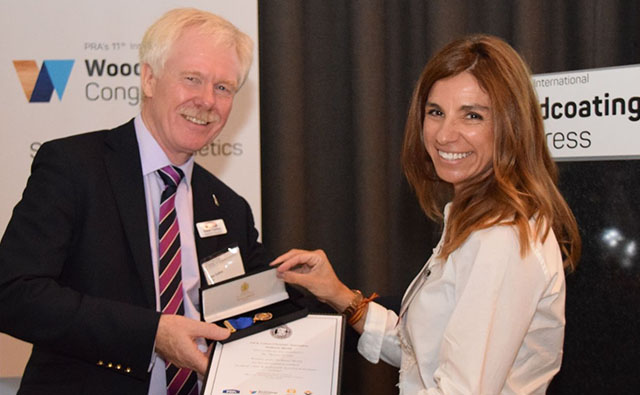Industry News, Coatings
Nature meets wood coatings

Industry News, Coatings

Image: Miriam Peralta from Lubrizol receives the Holbrow Medal for the best paper at the woodcoatings congress from Peter Collins. (Picture by Jan Gesthuizen, Posted via European Coatings)
Every two years, the wood coatings community comes together to discuss the latest technical developments as well as regulatory affairs. But most importantly, the PRA Woodcoatings Congress 2018 showed again that it is a family meeting.
Most trends influencing the wood coatings market are similar to the ones in other coatings areas such as automotive paints or corrosion protection. However, PRA’s 11th Woodcoatings Congress showed that nonetheless many nuances are different. One example is the topic of bio-based coatings that was quite visible during the congress.
During a poll, the attendees of this year’s conference were asked about the share of bio-based materials they expect to be using in their formulations in ten years. 45 % of all voters expected to use 10 – 30 %. While this is clearly more than today and would lead to a growing market for this type of raw materials, this is of course not the most ambitious expectation. However, 23 % of voters assumed a usage of 30 – 50 % bio-based material and 9 % even more than 50 %. This means that there is a number of players who aim for ambitious targets.

Figure 1. How much biobased material do you see in your formulations in 10 years? ©European Coatings
Several lectures addressed bio-based materials and illustrated that – in some cases – the technology is further along than one would expect. Presentations on bio-based fire retardants, silyated linseed oils, nano- and microfibrilated cellulose or binders based on itaconic acid showed there are many suitable materials out there, just waiting to be used.
However, in terms of sustainability there is still a lot to do in other areas, too. For example, the share of water-borne formulations is still relatively low as Thomas Bernhofer from Synthomer exemplified during his presentation. He explained that currently only about 35 % of DIY trim paints are water-based. The industrial sector is even worse, here you will find only around 15 % water-borne wood coatings.
Bernhofer said that he expects the share will most likely to rise in the future since regulations like National Emission Ceilings (NEC 2020/30) will probably reduce VOC boundaries to 50 mg/l or even 30 mg/l, which is much lower than today’s 130 mg/L. As he explained, this could lead to a more extensive usage of water-borne wood coatings, since the stricter benchmarks are already met by most water-borne systems. In countries with stricter regulations like Denmark or the Netherlands the water-borne-share is already at 90 % and more, Bernhofer underlined.
However, as the polls showed, the major issues for the wood coatings industry are seen somewhere else. Asked for the biggest pull for innovations, more than 50 % of the attendees voted for higher durability. Accordingly, most attendees voted for chemical resistance being the most important property that needs to be improved in water-borne wood coatings.
This was at least partially reflected in the presentation by this year’s winner of the congress award. Miriam Peralta of Lubrizol received the Holbrow Medal, given out by the Oil & Colour Chemists’ Association (OCCA). In her talk she presented findings that could lead to increased aesthetic values of polyamide-based polyurethanes while maintaining the high durability and resistance that polyurethanes are known for. Lubrizol compensated chemical features of polyamide polyols that are responsible for their typically high melting points and high glass transition temperatures as well for being relatively hard polyols.

Figure 2. Which of these properties need to be improved in water-borne wood coatings to make hem more competitive to solvent-borne systems? ©European Coatings
As Peralta explained, a major driver behind this development was the rising demand for matt coatings. Coatings formulated with this kind of polyurethanes showed good self-matting behaviour. Even though the matting had its limits at around 16 GU at 60°, the usage of matting agents could be reduced if an even higher matting is necessary. This could, as Miriam Peralta explained, reduce the negative impacts that using a high amount of silica or other matting agents could bring.
Maybe even more important than the lectures is the opportunity to speak personally to experts from the industry. The event in Amsterdam underlined that, within the coatings industry, the wood coatings community is possibly one of the most communicative ones. Some people described the event as a big family meeting. At times, it certainly felt like one.